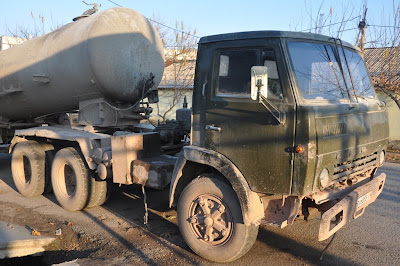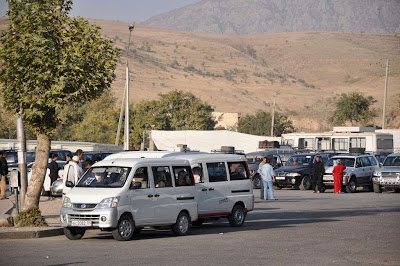These are pictures from Vahdat, a town about 20km east of Dushanbe. Vahdat has good connections with Dushanbe, many people commute into Dushanbe for work, there is always transport and the road connecting the two cities is very good. Vahdat, however, lacks electricity in the winter. Homes are supplied with electricity for only a few hours each day. I came to Vahdat once before with the World Food Program, who distributes food-aid to patients on TB treatment. Talking with a nurse at the health facility there, I said I liked Vahdat more than Dushanbe because it was a little calmer and quieter. She immediately offered me her house in trade for our apartment in Dushanbe, laughing, and said, "You have electricity there! You need to come back to Vahdat in the winter and see how you like it then!" She's right, I'm sure I would find it more difficult to live there in the cold.
Electricity is rationed for most places outside of Dushanbe, so that people have 3-4 hours per day when they can cook. Apparently this has to do with the water level in the main resevoir that supplies hydroelectic power to Dushanbe and most of the country. There is natural gas in the country, but the main supply is Uzbekistan, which doesn't like Tajikistan for various reasons ranging from ethnic feuds to water rights. Uzbekistan quotes Tajikistan a high price for natural gas, Tajikistan threatens to cut off Uzbekistan's water supply, etc. The political systems of each country are such that the population does not greatly influence the outcome of negotiations, and nobody really knows how deals do or don't get made. All people know is they have no way to cook or stay warm in the winter. Diesel and gas generators are popular, small ones produce enough electricity for lights. Only wealthy families have large generators that produce enough watts for heating.
Only the governments of our two countries know, but if all the gossip is true then Tajikistan is selling electricity to the US in Afghanistan. The US government likely pays more per KW than the rate charged to Tajiks, so this benefits the Tajik government. Frankly, I don't see how, when our electric bill for the month is under $10 even while running heaters, the electricity company makes any money. At the same time, for many rural Tajiks a rate hike would be similar to no electricity at all. However, a rate hike would allow people to make rationing decisions themselves.
A grandmother chatting with another grandmother

a guy with a sack of something. The robe he's wearing is called a Joma, which translates to clothes, basically. Clothing for the legs (poi) are called "poi-joma", which is likely where the word "pajama" comes from.

a house

I chatted with these guys for a while. The guys on the right lived in New York last year, working as a waiter and something else. Now he owns his own shop selling construction supplies. We talked about America, Tajikistan and why my passport doesn't have a 'nationality' listed. In the Soviet Union and post-Soviet states, passports have one's nationality (as decided by the Soviet Union) listed. This was partly for nation-building in the early 20th century, but I don't know why it stayed around, except as a means of control. So, since my passport didn't have my nationality listed, they asked me, "what nationality are you?" I said, "American." "no, that's not a nationality. America is made up of people from other places. You're not American." Having heard this quite often in Armenia, I gave my stock answer: "Half of my ancestors are from the Ukraine, and half are from Poland. They went to America about 150 years ago." "Ahhh" they replied, satisfied to know that I was Ukrainian or Polish. I don't even bother to get into the fact that I'm Jewish, but more atheist or pantheist or Spinozist than anything. Perhaps I should make a copy of my passport and photoshop in all of those things, just to mess with people.

Selling carrots and potatoes out of the back of trucks


Carpets at the Bazaar


A man working in the small plot of land between his house and the street.

A cement truck.

Apartment buildings in Vahdat.

The president of Tajikistan on a billboard overlooking the main square in Vahdat. The sign says, "Our politics are advantageous to people"

A village outside of Vahdat. I love mountains.

The bus stop in Vahdat.

These guys were attempting to load this cow, whose legs were bound together, into a wheelbarrow. It took them several tries, but eventually, with three men hanging off of the handle of the wheelbarrow, they got the cow up into it. I asked several people why they were moving the cow, but nobody knew--everyone else was just there to watch, too. If it were my cow, I would walk it on its own legs to where ever it needed to go, and then tie it up.


 Designs on the Ismoili Center. The blue bricks are actually script, but it's far too difficult for me to read it in this form.
Designs on the Ismoili Center. The blue bricks are actually script, but it's far too difficult for me to read it in this form.
 Diana and one of her English students, Uktam, in the inner courtyard of the Center. Uktam is a really nice guy.
Diana and one of her English students, Uktam, in the inner courtyard of the Center. Uktam is a really nice guy. The Death Star--I mean, Hyatt Regency Dushanbe. It is nice inside. It sits just opposite to the Ismoili Center (unfortunately).
The Death Star--I mean, Hyatt Regency Dushanbe. It is nice inside. It sits just opposite to the Ismoili Center (unfortunately).

























































